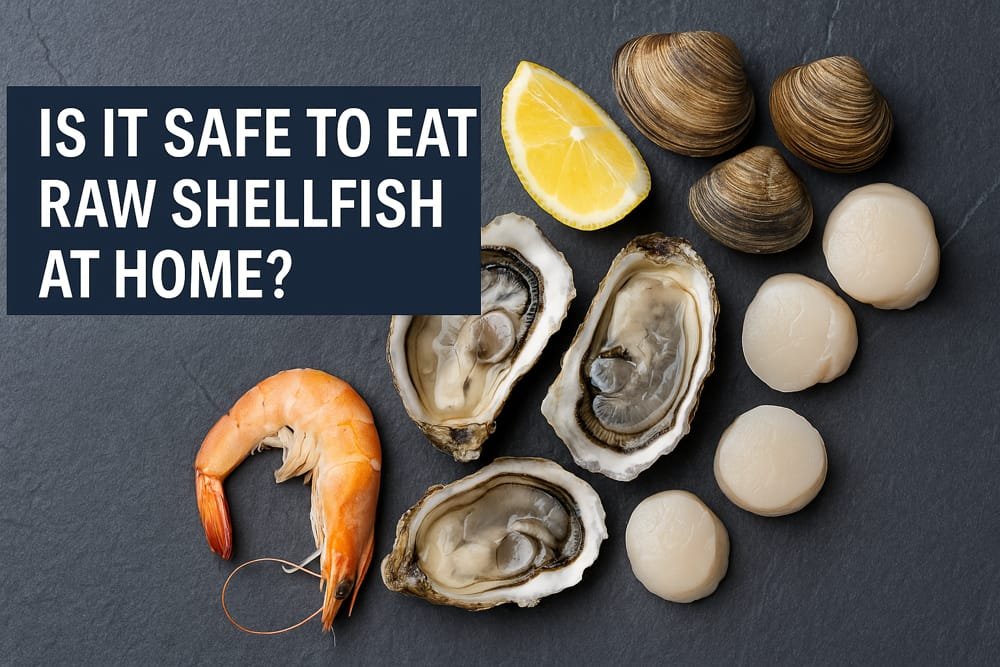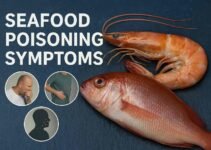Raw shellfish—like oysters, clams, and scallops—are considered delicacies in many cultures, often served fresh with minimal preparation. While enjoying raw shellfish at a seafood restaurant is fairly common, more and more home cooks are tempted to recreate that experience in their own kitchens. But this raises an important question: Is it safe to eat raw shellfish at home?
Unlike cooked seafood, raw shellfish carries unique food safety risks, especially when handling and sourcing are not properly controlled. Contaminated shellfish can harbor bacteria, viruses, and natural toxins that may lead to serious illness. This article explores the potential dangers, who’s most at risk, and what steps you can take to reduce those risks—so you can make an informed decision about whether raw shellfish has a place in your home kitchen.
Contents
- 1 What Is Considered “Raw Shellfish”?
- 2 The Main Risks of Eating Raw Shellfish
- 3 Who Should Avoid Eating Raw Shellfish?
- 4 Sourcing Matters: How to Choose Safe Shellfish
- 5 Handling and Storing Raw Shellfish Safely at Home
- 6 Can Freezing Kill Harmful Pathogens?
- 7 Should You Clean Raw Shellfish Before Eating?
- 8 Tips for Minimizing Risk When Eating Raw Shellfish at Home
- 9 Alternatives to Eating Raw Shellfish
- 10 Conclusion
What Is Considered “Raw Shellfish”?
Raw shellfish refers to any marine invertebrate consumed without being cooked through heat. This includes a variety of seafood such as oysters, clams, mussels, scallops, shrimp, crab, and lobster. For more details on identifying safe options, read our guide on How to Choose Sashimi-Grade Seafood. While some of these are more commonly eaten raw—like oysters on the half shell or sashimi-grade scallops—others are typically served cooked but may still be consumed raw or lightly cured in certain dishes.
It’s important to distinguish between raw, lightly cooked, and acid-cured preparations. For example:
- Raw oysters are often served freshly shucked, with no cooking or curing applied.
- Scallop sashimi is usually sliced and eaten raw, sometimes with wasabi and soy sauce.
- Ceviche, often made with shrimp or scallops, involves marinating the seafood in citrus juice, which alters the texture and flavor but doesn’t eliminate all microbial risks.
In all cases, these dishes rely heavily on the freshness and safety of the shellfish source, which becomes even more critical when handling them at home.
The Main Risks of Eating Raw Shellfish
Eating raw shellfish carries several health risks, primarily due to the potential presence of harmful microorganisms and naturally occurring toxins. Unlike fish that may be frozen to eliminate certain parasites, shellfish harvested from contaminated waters can contain pathogens that freezing or simple rinsing cannot remove.
Bacterial Contamination
The most common concern with raw shellfish is bacterial infection. Species like oysters and clams can harbor Vibrio vulnificus and Vibrio parahaemolyticus, which thrive in warm coastal waters. These bacteria can cause symptoms ranging from mild gastrointestinal discomfort to severe bloodstream infections, especially in individuals with underlying health conditions. Other bacteria, such as Salmonella and E. coli, may also be present in shellfish harvested from polluted waters.
Viral Infections
Viruses like norovirus and hepatitis A are also linked to raw shellfish consumption. These pathogens are highly contagious and can be transmitted through contaminated water or improper handling. Norovirus, in particular, is known for causing outbreaks linked to raw oysters, often affecting large groups of people in a short amount of time.
Parasites and Toxins
Though less common, some raw shellfish may contain parasites or biotoxins. Toxins such as those responsible for Paralytic Shellfish Poisoning (PSP) are produced by certain algae and cannot be removed by cooking, freezing, or washing. These can accumulate in filter-feeding shellfish like mussels and clams and pose a serious health threat if ingested. These risks are further discussed in our full article on Common Seafood Allergies: What You Need to Know.
Who Should Avoid Eating Raw Shellfish?
While many people can consume raw shellfish without immediate issues, certain individuals face significantly higher health risks and are advised to avoid them altogether. This is particularly true for people with compromised immune systems, liver disease, or chronic health conditions that reduce the body’s ability to fight infections.
Those most at risk include:
- Pregnant women
- Elderly individuals
- Young children
- People undergoing cancer treatment
- Individuals with diabetes, HIV, or liver disorders (including hepatitis or cirrhosis)
For these groups, even a small exposure to harmful bacteria like Vibrio vulnificus can lead to severe, sometimes fatal, infections. The U.S. Centers for Disease Control and Prevention (CDC) and Food and Drug Administration (FDA) both recommend that at-risk individuals avoid consuming raw or undercooked shellfish. Understanding one’s vulnerability is essential when deciding whether raw shellfish is a safe dietary choice.
Sourcing Matters: How to Choose Safe Shellfish
Selecting the right shellfish is the first and most crucial step in minimizing the risks of eating them raw at home. Shellfish safety starts with the environment where they are harvested and continues through every stage of processing and handling.
Buy From Trusted, Reputable Sources
Avoid purchasing shellfish from street vendors, unverified markets, or sources that do not follow regulatory guidelines. Instead, choose seafood purveyors or markets known for high hygiene standards and transparent sourcing. Many reputable suppliers only stock shellfish from monitored waters, where harvesting is strictly controlled to prevent contamination.
Look for Certification
In the United States, raw molluscan shellfish (like oysters and clams) should come with tags or labels indicating harvest location, date, and certification from a state shellfish control authority. These tags help trace the origin and confirm compliance with safety standards. If you’re outside the U.S., check whether your country requires similar certifications from national food safety bodies.
Signs of Freshness
When purchasing live shellfish such as oysters or mussels, check that the shells are tightly closed. This indicates that the animal is alive and fresh. Any shell that is cracked, open, or has an unusual odor should be discarded. Fresh scallops should appear firm, slightly translucent, and smell like clean ocean water—not fishy or sour. For shrimp and crab, look for firm texture and a natural sheen, without excessive slime.
Handling and Storing Raw Shellfish Safely at Home
Even high-quality shellfish can become unsafe if mishandled at home. Proper storage and handling practices are essential to prevent bacterial growth, cross-contamination, and foodborne illness.
Proper Refrigeration
Raw shellfish should be stored at a constant temperature below 40°F (4°C). Ideally, they should be kept on ice or in the coldest part of your refrigerator and consumed as soon as possible after purchase. Live mollusks like clams and mussels should be stored unshucked in a breathable container (e.g., mesh bag or bowl covered with a damp towel), not in sealed plastic, as they need airflow to stay alive.
Avoiding Cross-Contamination
Always keep raw shellfish separate from cooked foods, fruits, and vegetables. Use different cutting boards and knives when preparing shellfish to avoid spreading harmful bacteria. After handling raw seafood, wash hands, surfaces, and utensils thoroughly with hot, soapy water before touching anything else in the kitchen.
Storing Live Shellfish
Live shellfish should never be submerged in water or placed directly on ice, as this can suffocate them. Instead, place them in a colander inside a bowl and store them in the refrigerator with a damp towel on top. Discard any shellfish that do not close when tapped or have broken shells—they are likely dead and unsafe to eat raw.
Can Freezing Kill Harmful Pathogens?
Freezing is often thought of as a reliable way to kill parasites and pathogens in seafood, but its effectiveness varies depending on the type of contaminant and the shellfish in question. For certain types of fish—like salmon used for sashimi—deep freezing at temperatures of -4°F (-20°C) for at least seven days can neutralize many parasites. However, when it comes to shellfish, freezing is not a guaranteed method of making them safe to eat raw.
While freezing may reduce the presence of some parasites in shellfish such as scallops or shrimp, it does little to eliminate bacteria like Vibrio or viruses like norovirus. These pathogens are often deeply embedded in the tissues of filter-feeding shellfish like oysters or clams and are resistant to cold temperatures.
Moreover, freezing cannot neutralize naturally occurring biotoxins, such as those that cause Paralytic Shellfish Poisoning (PSP). For these reasons, freezing should not be relied upon as a substitute for proper sourcing and food safety protocols. Always treat previously frozen raw shellfish with the same caution as fresh raw shellfish.
Should You Clean Raw Shellfish Before Eating?
Cleaning raw shellfish is a good practice, but it’s important to understand its limitations. While rinsing and scrubbing the outer shell of clams, mussels, or oysters can remove surface grit and debris, it does not sterilize the interior or eliminate microscopic pathogens.
Shellfish are filter feeders, meaning they concentrate bacteria and viruses from their surrounding environment in their tissues. No amount of rinsing or scrubbing can remove these internal contaminants. In fact, opening the shell or shucking the meat exposes the inner tissues directly, increasing the need for strict hygiene when handling them.
However, certain steps can help reduce visible dirt and improve overall food quality:
- Scrub shells with a stiff brush under cold running water
- Soak shellfish like clams in salted water to purge sand
- Discard any that have cracked shells or remain open when tapped
If you’re preparing scallops or shrimp, removing the digestive tract or “vein” is also a common practice, although this is more about texture and aesthetics than safety. Ultimately, cleaning helps with presentation but is not a reliable method of disinfection.
Tips for Minimizing Risk When Eating Raw Shellfish at Home
Although the risks associated with raw shellfish can never be entirely eliminated, there are several precautionary steps you can take to significantly reduce your chances of foodborne illness when preparing these delicacies at home.
Choose Low-Risk Shellfish
Not all shellfish pose the same level of danger when eaten raw. For example, scallops and shrimp tend to carry fewer pathogens than filter-feeding mollusks like oysters or clams. Choosing bivalves from colder, regulated waters and selecting species that are less prone to harboring harmful microorganisms can make a difference.
Eat Immediately After Preparation
The longer raw shellfish sits out at room temperature, the more opportunity bacteria have to multiply. Always prepare and serve raw shellfish as close to consumption time as possible. Avoid letting it sit on the counter, and never consume leftovers that have been stored for hours unrefrigerated.
Consider Light Cooking or Acid Curing
If you want the texture and flavor of raw shellfish without the full risk, consider light cooking techniques like searing scallops or lightly steaming clams. Alternatively, acid-curing methods—such as in ceviche—can offer a partial safeguard, though they do not fully kill pathogens. Lemon or lime juice may denature proteins, but they are not substitutes for heat or certified safety standards.
Alternatives to Eating Raw Shellfish
If you’re hesitant about the risks associated with raw shellfish—or fall into a high-risk group—there are plenty of delicious alternatives that still celebrate the natural flavor and texture of shellfish without compromising safety. Cooking shellfish properly doesn’t mean sacrificing quality. In fact, many preparation methods enhance their natural sweetness and briny freshness.
Here are some safer yet equally satisfying options:
- Grilled Oysters or Mussels: Lightly grilled oysters retain their juicy interior while eliminating harmful pathogens. A squeeze of lemon or a dash of garlic butter adds richness without overpowering the ocean flavor.
- Seared Scallops: A quick pan sear on high heat caramelizes the outside while keeping the center tender and moist—a great substitute for scallop sashimi.
- Butter-Poached Shrimp or Lobster: Gently cooking in butter at low temperatures results in a silky, luxurious texture that mimics raw preparations but ensures safety.
- Steamed Clams with Wine and Herbs: This method preserves the shellfish’s delicate taste while removing any microbial risks.
Choosing these alternatives lets you enjoy shellfish confidently, especially when cooking for guests or vulnerable family members.
Conclusion
Eating raw shellfish at home can be tempting, especially for seafood enthusiasts seeking a gourmet experience. However, it’s essential to recognize the real risks involved—bacterial infections, viral illnesses, and natural toxins are all serious health concerns, particularly for high-risk individuals. While quality sourcing, safe handling, and proper storage can reduce the likelihood of contamination, they cannot eliminate it entirely.
For those determined to enjoy raw shellfish at home, the key lies in vigilance: choose certified suppliers, keep shellfish refrigerated, handle them with care, and consume them immediately after preparation. Still, even with the best precautions, some level of risk remains.
When in doubt, opt for cooked shellfish alternatives that preserve flavor and texture while ensuring food safety. A cautious approach helps protect not only your health but also that of your family and guests—making your culinary experience both enjoyable and responsible.



